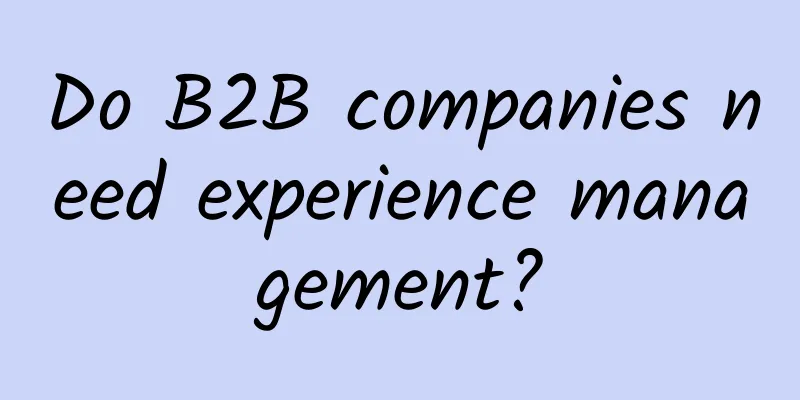|
With the maturity of the overall economic environment, more and more industries have transformed from incremental markets to stock markets in recent years, and homogeneous competition among products has intensified. In order to break the deadlock, companies have begun to cultivate their internal strengths, carry out refined operations in their business, and pay more and more attention to customer experience. Many companies hope that customer experience will become the new engine of the next growth curve. However, in the past, the growth of B2B companies was often driven by strong sales, and management did not pay enough attention to experience management, and their development in experience management lagged far behind that of B2C companies . According to Betadata's 2022 Customer Experience Maturity Survey, nearly 70% of B2B practitioners believe that their companies are still in the starting and development stages of experience management; in contrast, more than 40% of B2C companies have entered the stage of perfection and excellence. The maturity of experience management is also reflected in the internal management mechanism of the enterprise. B2B enterprises lag significantly behind B2C enterprises in terms of dedicated experience departments, senior management involvement, experience management processes and assessment mechanisms . The public's increased attention and understanding of experience has gradually permeated into B2B purchasing decisions, forcing companies to strengthen their customer experience management capabilities. Currently, many B2B companies have realized this gap and have begun to invest more resources in experience management. Based on the past project experience of Bebito, this article further reflects on and summarizes B2B experience management, and expands on the characteristics of B2B customer experience management, the composition of the experience model, and solution recommendations . Three key characteristics of B2B experience management B2B purchasing behavior is quite different from personal purchasing in terms of participants, decision-making logic, and demand focus. If companies want to do a good job in B2B experience management, they must first understand its three major characteristics that are different from B2C experience management. 01. More participating roles B2B purchasing decisions involve a large number of stakeholders. A purchase behavior may involve multiple roles such as company managers, purchasing managers and users . In different types of companies, the impact of these roles on decision-making varies. According to data from the 2021 B2B Buyer Report, the vast majority of B2B buyers have 2-4 people involved in purchasing decisions, and more than 20% of buyers have 5 or more people involved. It is not realistic to always provide an excellent customer experience for all stakeholders , which requires B2B companies to develop specific strategies and make trade-offs. The premise of making choices is to make a clear judgment on the influence of different roles in purchasing decisions. For example, when purchasing precision electronic components, engineers as users have the strongest voice and can veto suppliers they are dissatisfied with; but when companies purchase holiday benefits for employees, the core decision maker may be the chairman of the union responsible for purchasing, and employees as actual users have little influence on purchasing decisions. Therefore, B2B companies must identify key roles when doing experience management, so as to be targeted and not spend limited resources on insignificant roles. 02. The decision-making process is more complicated The decision-making chain of C-end customers is short and more emotional and subjective. In contrast, the decision-making process of B-end buyers is more complex, usually longer and involves multiple processes . When evaluating products or services, purchasers must consider more specific requirements at the company level, such as internal compliance considerations, financial and payment terms, service levels, logistics requirements, etc. Purchases of large amounts are often carried out in the form of internal review meetings or public bidding, with strict process control and scoring standards, which also makes B2B purchasing decisions often based on rationality. However, when people are involved, there will inevitably be emotional factors. Even in more rational B2B procurement, the subjective emotions of the participants will also have a certain impact on the decision-making . For example, as an individual consumer, their purchasing preferences, their trust in the account manager, and their good impression of the brand will prompt them to make judgments that are more favorable to the supplier. According to the 2021 B2B Buyer Report, more than 80% of B2B decision makers said they would be more inclined to purchase a certain brand if they had a positive impression of the brand before conducting supplier research. 03. Customization requirements are more rigid Customized services are a common means of creating an experience that exceeds expectations for B2C businesses, but they are a rigid demand of B2B businesses. The personalized services provided by enterprises may be taken for granted by B-side customers, which will directly affect their choice of suppliers. If enterprises cannot meet their needs, it may greatly affect their wallet share and even lead to their elimination from the competition. From the perspective of company operations, blindly satisfying customers' overly personalized needs is not advisable . On the one hand, it will bring additional costs, and on the other hand, it will increase the difficulty of managing the company's products and services, making it difficult to achieve scale advantages. How to strike a balance between operational efficiency and meeting customized needs is also a difficult problem in B2B experience management. A good approach is to segment customers based on customer groups, so that the company can create a more customized experience for the core group. However, compared with the mature user portrait research methods in the B2C industry, customer segmentation in the B2B industry started late. Most companies do not have unified rules at the headquarters level, and the satisfaction of specific customized needs is left to the front-line staff to respond flexibly. Front-line staff lack strategic guidance and usually make simple judgments based on their own business experience, which makes it difficult to maximize the value of resources. The components of the B2B experience model Based on the three major characteristics of B2B experience management, Bebito further explored the many factors that affect customer experience, and based on the commonalities of past cases, summarized a B2B customer experience model that includes three forces and three senses . Among them, product strength, price strength, and contract performance are rational demands of customers, and are more of an assessment of the hard comprehensive strength of the enterprise. At the same time, as basic items of customer experience, they are the tickets for enterprises to enter the market competition ; A sense of peace of mind, importance, and trust are the emotional needs of customers. They are more about the perception of the company's soft service level. At the same time, as a plus point for customer experience, they affect customer retention and turn one-time business into sustainable business . Rational needs: Basic items, tickets to enter market competition Ensure product quality and richness Product strength is the most intuitive source of customer experience , and its influence is mainly reflected in two aspects: on the one hand, product quality . For more professional products such as precision instruments, B2B buyers usually have clear brand and parameter standards, while for less professional products such as labor protection products, they mainly rely on feedback from actual users. On the other hand, there is the variety of products. If many of the products that customers need are not available, the customer experience will be significantly reduced. However, from the perspective of business operations, blindly pursuing a rich variety of products will lead to difficulties in SKU management and will not be able to achieve scale advantages. How to achieve a balance between the two? First, pay attention to the sorting of products commonly used by customers . When a certain number of customers have needs, they should be introduced in a timely manner, so as not to leave customers with the impression that "even this is not available"; second, pursue the introduction of special products or private brands , and create an impression of "I have what others don't have" around different customer groups. Meet customers' cost control needs The first priority of B2B procurement is cost control, which is particularly evident in the manufacturing industry with relatively low profit margins. Many factory purchasers have a 3%-5% cost reduction target every year. B2B companies must meet their customers' demand for cost control, but be aware that sometimes the advantages brought by too low prices are not as obvious as expected . On the one hand, due to quality risk considerations, purchasers are not inclined to use suppliers with too low prices. On the other hand, a certain low price will increase the financial explanation cost of procurement personnel, and they will need to provide sufficient evidence to prove why the price has increased the next time they purchase.Deliver the promised content on time and in quality In B2B business, suppliers provide customers with not only single products and services, but also comprehensive solutions, which usually require longer delivery cycles, so the impact of contract performance in the process is also greater. In most companies, especially those within the system, the impact of contract performance is even greater than the reduction in procurement costs. B2B companies attach great importance to the construction of fulfillment capabilities, but the difficulty they face is that they don't know where the fulfillment problems lie . In previous surveys, Bebito found that due to KPI assessment factors, most problems were eliminated by regional front-line personnel, and what was presented to the company's management was likely just a beautified perfect fulfillment rate indicator. To solve this problem, B2B companies can start to increase digital touchpoints with customers, such as online mini-program confirmation, instant text messages after fulfillment is completed, etc., use scenario NPS to collect feedback on each fulfillment, and at the same time combine operational indicators such as fulfillment rate to formulate the direction that needs to be focused on in the future. Emotional needs: Bonus points, turning a one-time business into a sustainable one Simple and transparent, daily purchasing work is easier Easier communication: Reduce the time spent by procurement roles in coordinating between different roles . B2B procurement products and procurement processes are more complex. Different people are often responsible for collecting requirements, placing orders, reviewing, receiving goods, and using them. The procurement role undertakes a lot of coordination work. B2B companies should think about how to create direct communication points with different stakeholders of customers to reduce the difficulty and energy consumption of procurement roles in mediation. The process is more transparent: prices, inventory, performance standards, orders or problem handling progress are transparent and traceable. A more transparent process not only ensures information equality between buyers and sellers, but also enhances the level of control over the work of procurement roles, giving procurement more confidence . More efficient response: Respond to customer demands quickly and stably, and give accurate answers even if they cannot be resolved in a short time. The supplier's response speed is directly linked to the maintenance of customer relationships. In the survey conducted by Bebito, many purchasing managers said that when their temporary order needs can be responded to in a timely manner, or their improvement suggestions can be quickly fed back to the supplier's management, their favorability will increase significantly. Help me show my work results in the company A sense of presence is a deeper emotional appeal than peace of mind. The work of procurement personnel is usually not easy to be understood. They will not be praised for doing a good job, and will be questioned by many parties when problems arise. Most procurement personnel spend their time and energy on not making mistakes, but deep down they also hope that their work performance can be seen by their leaders and recognized by their employees. If suppliers can help procurement personnel build their "sense of presence" within the company, it will greatly increase customer stickiness. This practice is used in different industries. For example, some companies that value customer experience will help purchasing staff organize cost reduction data, or share the excellent experiences of other companies in the same industry. In this way, they can help purchasing staff better report to leaders and showcase their work results. The account manager is professional and reliable, and long-term cooperation is more assured In B2B business, account managers usually play an important role as interpersonal liaisons, responsible for daily communication with customers and solving problems. The relationship between account managers and customers often affects the overall experience from products to services, and even further determines customer retention. In the survey conducted by Bebito on B2B customers, many purchasing staff said that because the current account manager is conscientious and thoughtful and understands the company's needs, although the supplier is not the best choice in terms of product and price, they are still willing to maintain long-term cooperation. Therefore, B2B companies need to spend more energy on training service personnel to meet customers' expectations of service personnel and build trust. How to Create B2B Customer Experience 1. Start from rational needs and highlight the core competitiveness of the enterprise. We can better focus on rational needs such as product strength, price power and fulfillment power, and find out the links that can form core advantages. For example, in the corporate welfare gift industry, JD.com uses its own logistics to create a differentiated advantage , which is faster and more stable in the fulfillment link, and can even provide customized logistics services. In the field of industrial products, MISUMI focuses on product strength and is famous for the precision and customization of its products . Many customers complain about its long delivery cycle, high prices and cumbersome service processes, but they still continue to purchase. The reason is that they are more confident in the quality of MISUMI's products and cannot be bought from other companies. 2. Identify key roles and create a sense of "peace of mind" in a targeted manner. With the help of multi-role customer journey tools, identify key decision makers and users in the company's procurement journey, and focus on meeting their needs for "peace of mind". It should be noted that key roles may change in the two different stages of establishing cooperation and daily ongoing cooperation. Taking industrial product procurement as an example, in the stage of establishing cooperation, the decision of the purchasing director has the greatest impact and can directly determine whether to enter the supplier cooperation list; but in the stage of daily ongoing cooperation, the voice of the workshop engineer cannot be ignored. It is not only directly related to the wallet share of each supplier, but also can affect the renewal of the contract after the expiration of the contract. 3. Provide accurate value-added services with the help of customer segmentation. Providing customers with value-added services that exceed their expectations can help enhance their sense of being valued, but this process is costly and the needs of different customers vary greatly. Enterprises should provide differentiated value-added services to different key customer groups on the basis of good customer segmentation in order to maximize the value within controllable costs. Taking industrial product procurement as an example, large-scale central enterprise customers purchase more complex products and hope that someone can help them communicate product needs; small-scale private enterprise customers have fewer staff and hope that delivery personnel can help them complete the work of sorting and putting goods on the shelves. 4. Balance the relationship between digital touchpoints and interpersonal touchpoints. Most B2B companies are also fully committed to digitalization, hoping to reduce manpower investment and improve customer experience. However, unlike B2C digitalization, B2B digitalization should not eliminate the touchpoints between business personnel and customers . When providing digital tools, companies should consider whether the touchpoints between original business personnel and customers will be damaged, and whether it can bring about a significant improvement in service quality and labor efficiency. 5. Highlight the brand connotation and reject the “big business, small brand” mentality. Most B2B companies are sales-driven and pay relatively little attention to the brand. In this case, the turnover of sales staff often represents customer loss. From the perspective of reducing customer loss, brand is an important starting point and a long-term asset for the company. Therefore, while focusing on building hard power, B2B companies should also start brand building as early as possible, solidify the company's rational competitive advantages and emotional service characteristics into brand connotations, and highlight them in brand building to avoid the problem of “big business, small brand” , that is, the company's product sales or reputation are very good, but customers are not impressed enough by the company's brand, or it runs counter to the brand image that the company wants to create. Case Study – Zhenkunxing Industrial Supermarket Zhenkunxing Industrial Supermarket is a digital industrial supplies service platform that provides customers with one-stop industrial supplies procurement and management services , achieving transparency, efficiency and cost reduction in the industrial supplies supply chain . The company insists on achieving customer success, and puts customer experience in the most important position from the CEO to the front-line employees. In response to customers' rational demands, Zhenkunxing focuses on the construction of fulfillment capabilities. Based on the national warehouse, it has set up regional service centers to solve the last mile service and distribution problems and ensure that products can be delivered to customers on time and accurately. In order to create a more extreme customer experience, it assigns full-time delivery managers to customers in need, providing customers with 360-degree services such as classification, warehousing, and shelving. In response to the emotional demands of customers, Zhenkunxing is committed to creating a "peaceful and transparent" service experience. Through customer journey tools, we discover the needs and concerns of different types of customers and different roles, and provide targeted value-added services, such as providing common SKU sorting for large central enterprise customers with more purchasing categories to reduce the workload of procurement; providing product selection consultation for industry customers with more professional purchasing to help engineers solve technical problems. On the other hand, we insist on transparency in prices, product information and order tracking, enhance the control of procurement personnel over orders, and achieve more peace of mind. Meeting customers' rational and emotional needs is supported by the company's organizational culture. To continuously optimize customer experience, the CEO and company management will listen to customer feedback and study customer experience issues at each weekly meeting . At the same time, they will promote a "customer-centric" culture within the organization and set up a dedicated experience department, hoping that customer experience can become the company's DNA . In the existing market with severe homogeneous competition, experience management has become a key link in the refined operation of B2B enterprises; enterprises need to grasp two points when carrying out experience transformation: first, recognize the essential difference between B2B and B2C experience management; second, on the basis of continuously improving hard strengths such as products, prices, and fulfillment, further grasp the emotional needs of customers, find the most critical people in purchasing decisions, and provide effective services. Experience management is not only about pursuing the improvement of NPS/satisfaction numbers, but also about building a moat with the help of customer experience under limited resources, forming differentiated competitiveness, and turning one-time transactions into sustainable businesses. From: beBit |










